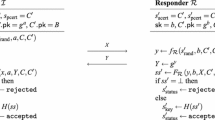Abstract
Recent work by Krawczyk [12] and Menezes [16] has highlighted the importance of understanding well the guarantees and limitations of formal security models when using them to prove the security of protocols. In this paper we focus on security models for authenticated key exchange (AKE) protocols. We observe that there are several classes of attacks on AKE protocols that lie outside the scope of the Canetti-Krawczyk model. Some of these additional attacks have already been considered by Krawczyk [12]. In an attempt to bring these attacks within the scope of the security model we extend the Canetti-Krawczyk model for AKE security by providing significantly greater powers to the adversary. Our contribution is a more compact, integrated, and comprehensive formulation of the security model. We then introduce a new AKE protocol called NAXOS and prove that it is secure against these stronger adversaries.
Preview
Unable to display preview. Download preview PDF.
Similar content being viewed by others
References
Bellare, M., Palacio, A.: The Knowledge-of-Exponent Assumptions and 3-Round Zero-Knowledge Protocols. In: Franklin, M. (ed.) CRYPTO 2004. LNCS, vol. 3152, pp. 273–289. Springer, Heidelberg (2004)
Bellare, M., Pointcheval, D., Rogaway, P.: Authenticated Key Exchange Secure Against Dictionary Attacks. In: Preneel, B. (ed.) EUROCRYPT 2000. LNCS, vol. 1807, pp. 139–155. Springer, Heidelberg (2000)
Bellare, M., Rogaway, P.: Entity Authentication and Key Distribution. In: Stinson, D.R. (ed.) CRYPTO 1993. LNCS, vol. 773, pp. 110–125. Springer, Heidelberg (1994)
Bellare, M., Rogaway, P.: Random Oracles are Practical: A Paradigm for Designing Efficient Protocols. ACM Conference on Computer and Communications Security, 62–73 (1993)
Bellare, M., Rogaway, P.: Provably Secure Session Key Distribution: the Three Party Case. In: STOC 1995. Proc. 27th Annual Symposium on the Theory of Computing, ACM Press, New York (1995)
Bellare, M., Rogaway, P.: Introduction to Modern Cryptography. Course notes for UCSD cryptography course, available at http://wwwcse.ucsd.edu/users/mihir/cse207/classnotes.html
Blake-Wilson, S., Johnson, D., Menezes, A.: Key Agreement Protocols and their Security Analysis. In: Darnell, M. (ed.) Cryptography and Coding. LNCS, vol. 1355, pp. 30–45. Springer, Heidelberg (1997)
Choo, K.-K.R., Boyd, C., Hitchcock, Y.: Errors in Computational Complexity Proofs for Protocols. In: Roy, B. (ed.) ASIACRYPT 2005. LNCS, vol. 3788, pp. 624–643. Springer, Heidelberg (2005)
Choo, K.-K.R., Boyd, C., Hitchcock, Y.: Examining Indistinguishability-Based Proof Models for Key Establishment Protocols. In: Roy, B. (ed.) ASIACRYPT 2005. LNCS, vol. 3788, pp. 585–604. Springer, Heidelberg (2005)
Choo, K.-K.R.: A Proof of Revised Yahalom Protocol in the Bellare and Rogaway (1993) Model. The Computer Journal, Oxford University; also available at Cryptology ePrint Archive: Report 2007/188 ( to appear, 2007)
Canetti, R., Krawczyk, H.: Analysis of Key-Exchange Protocols and Their Use for Building Secure Channels. In: Pfitzmann, B. (ed.) EUROCRYPT 2001. LNCS, vol. 2045, pp. 453–474. Springer, Heidelberg (2001)
Krawczyk, H.: HMQV: A High-Performance Secure Diffie-Hellman Protocol. In: Shoup, V. (ed.) CRYPTO 2005. LNCS, vol. 3621, pp. 546–566. Springer, Heidelberg (2005)
Jeong, I.R., Katz, J., Lee, D.H.: One-Round Protocols for Two-Party Authenticated Key Exchange. In: Jakobsson, M., Yung, M., Zhou, J. (eds.) ACNS 2004. LNCS, vol. 3089, Springer, Heidelberg (2004)
Kudla, C., Paterson, K.G.: Modular Security Proofs for Key Agreement Protocols. In: Roy, B. (ed.) ASIACRYPT 2005. LNCS, vol. 3788, pp. 549–565. Springer, Heidelberg (2005)
Lauter, K., Mityagin, A.: Security Analysis of KEA Authenticated Key Exchange. In: Yung, M., Dodis, Y., Kiayias, A., Malkin, T.G. (eds.) PKC 2006. LNCS, vol. 3958, pp. 378–394. Springer, Heidelberg (2006)
Menezes, A.: Another look at HMQV. Journal of Mathematical Cryptology (to appear)
Okamoto, T., Pointcheval, D.: The Gap Problems: A New Class of Problems for the Security of Cryptographic Schemes. In: Kim, K.-c. (ed.) PKC 2001. LNCS, vol. 1992, pp. 104–118. Springer, Heidelberg (2001)
Author information
Authors and Affiliations
Editor information
Rights and permissions
Copyright information
© 2007 Springer-Verlag Berlin Heidelberg
About this paper
Cite this paper
LaMacchia, B., Lauter, K., Mityagin, A. (2007). Stronger Security of Authenticated Key Exchange. In: Susilo, W., Liu, J.K., Mu, Y. (eds) Provable Security. ProvSec 2007. Lecture Notes in Computer Science, vol 4784. Springer, Berlin, Heidelberg. https://doi.org/10.1007/978-3-540-75670-5_1
Download citation
DOI: https://doi.org/10.1007/978-3-540-75670-5_1
Publisher Name: Springer, Berlin, Heidelberg
Print ISBN: 978-3-540-75669-9
Online ISBN: 978-3-540-75670-5
eBook Packages: Computer ScienceComputer Science (R0)




